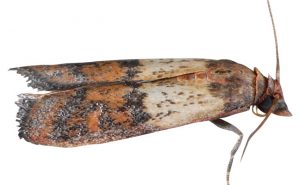Locating the source of an infestation may be more challenging than expected.

Photo: Mark Dreiling, Bugwood.org
To think out of the box, you must start with a bigger picture of the subject. When you’re searching for the breeding source of stored product pests, try not to be boxed in by the commonly used term “pantry pests.” Granted, many such pests are located within the pantry, but pest management professionals (PMPs) must think beyond this. Try finding tougher locations.
Here are examples to stretch your mind — and additional territories to inspect:
- The eggs of many moths, as well as some beetles and other arthropods, are deposited in foodstuff. For much of their immature life, larvae also dwell in food. When it comes time to pupate, however, they crawl off. If these viable pupae are not located and destroyed, the emerging adults will come back to attack new food products in the pantry.
- Check any cookbooks adjacent to the pantry. Many will harbor pupae. Also check the corners of shelving and along the ceiling moldings.
- Inspect couches, chairs and other resting areas where people sit and eat. Check deep into crevices behind pillows and cushions, which can catch crumbs and spillage.
- Most adult moths and beetles are attracted to lighting when the rest of the room is dark. The insects then die near the lighting, but are not in visible sight of the breeding area. Even the nightlight on a refrigerator’s icemaker can end up with several Indianmeal moths (Plodia interpunctella), for example.
- A wet bar of soap on a bathroom counter may catch beetles that fly to a nightlight, where they feign death and get caught on the soap.
- Are mice active in the account? They often stockpile granular rodent bait, dog biscuits and other solid food treats in wall voids, which in turn attract pantry pests. You may have to open a wall to eliminate the breeding source. Trying to cover it with a pesticide dust via a drilled hole does not work unless you first vacuum the food material.
- Some pantry pests can breed in items other than food. Examples include cigarettes, cigars, drugs, bird seed and dead insects like those found in wasp nests, bird nests and honey bee hives. Some Dermestids (carpet beetles and hide beetles) feed on grain products, as well as on feathers, hides and fur.
- When supermarkets run a “buy one, get one free” sale on cereal, pet food and the like, people can end up buying so much that there’s no room in the pantry to store it all. The overflow winds up in the laundry room, the garage, under a bed, or even in the basement or attic. Ask clients where they store extra food.
Once you think you have it all covered, toy beanbags or school projects made of food and stored in a random drawer could end up being the culprit. That’s what makes this job so challenging, interesting and why it requires continuous learning. When you do finally locate the source, the thrill of victory leaves you with a smile on your face and pride in your professionalism.
Much like life, the journey (inspection) is the important and exciting venture. The destination (finding the breeding source) is the ultimate ending.
Contributor Dr. Austin M. Frishman, BCE-Emeritus and a PMP Hall of Famer, can be reached at PMPEditor@northcoastmedia.net.
Leave A Comment